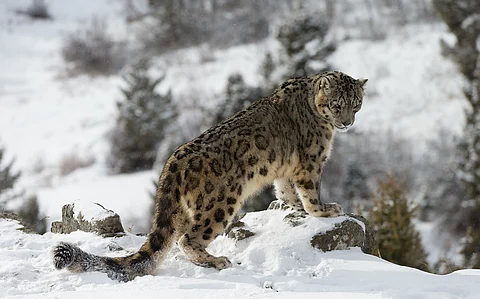

The Sanjiangyuan area of China’s Qinghai province, part of the Tibetan Plateau, holds a population of 1,000 snow leopards (Panthera uncia), comprising 11~21 per cent of the global snow leopard population. This makes it a bastion of the rare felid, a new study has said.
The findings are significant as China is estimated to encompass 60 per cent of the snow leopard habitat, making the country crucial for global snow leopard conservation.
Sanjiangyuan contains the headwaters of three of East and Southeast Asia’s great rivers — the Yellow, the Yangtze and the Mekong.
The researchers also noted that the high numbers of snow leopards in the area could be due to its large numbers of bharal or blue sheep.
“Previous diet analysis of snow leopards in this region indicated that bharal (Pseudois nayaur) accounted over 80% of their food intake (Lu et al. 2021). Bharal density here ranks among the world’s highest, as reported in an earlier study (Xiao et al. 2022), which may explain the high snow leopard density found in this research,” the sudy noted.
The researchers “combined and standardized existing camera trap survey data from 12 sites collected by four organizations during 2015~2021 to estimate snow leopard population in an area of 360,000 sq km on the Tibetan Plateau, China”.
They calculated an average snow leopard density of 0.90 /100 sq km and a population size of 1,002 individuals for the defined snow leopard habitat.
Two more conservative estimates of 971 and 978 individuals were generated within two defined survey regions, in which the data had higher representativity.
The population could be anywhere between 755 and 1,341 snow leopards, with a likely mean of 1,000 animals.
The snow leopard is a flagship species of Central and South Asia’s mountains. It is estimated to occupy an area of approximately 2 million sq km.
The International Union for Conservation of Nature (IUCN) had downgraded the snow leopard’s conservation status from ‘Endangered’ to ‘Vulnerable’ in 2017, based on population size estimations using predicted ecological parameters. “However, concerns about potential biases in population size estimation have led to controversy surrounding this downgrading,” the study said.
It added that understanding the population status and the factors influencing the apex predator was essential for conservation planning for the species, and the protection of its habitats, which include alpine, subalpine and semi-arid ecosystems.
The research aimed “…to provide the first large-scale snow leopard population density and size estimation in China”.
“Through this research, we seek to establish a framework for rapid large-scale snow leopard population estimation using existing datasets, contributing to more efficient and effective conservation efforts,” the authors wrote.
First large‑scale assessment of snow leopard population in China using existing data from multiple organizations has been published in Biodiversity and Conservation.
The authors are Xueyang Li, Chunyue Wei, Xier Chen, Ding Jia, Peiyun Li, Shujie Liang, Awang Jikmed, Yufang Gao, Xiang Zhao, Moyan Chu, Koustubh Sharma, Justine Shanti Alexander, Zhi Lu and Lingyun Xiao.